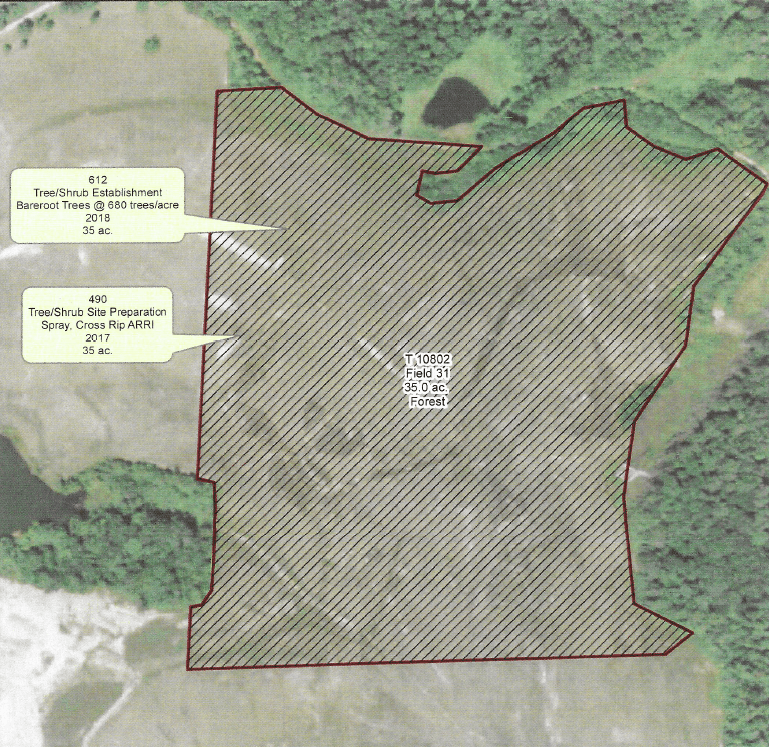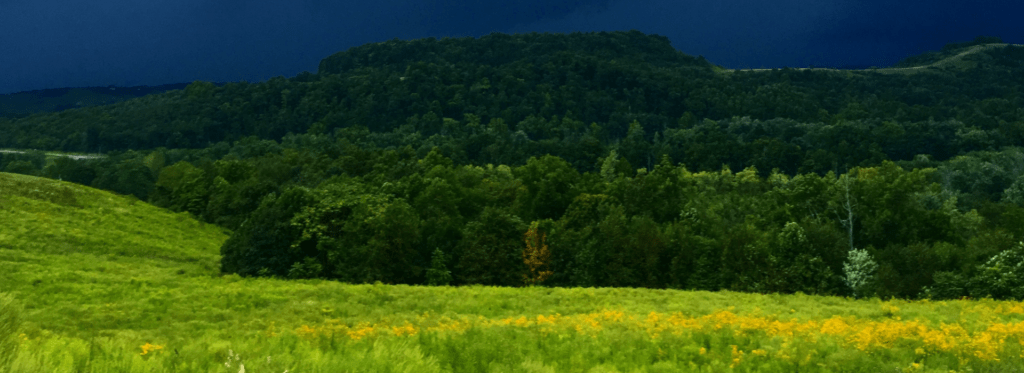Reforestation of Reclaimed Strip Mine 2017-2018
Description
This carbon offset project converted 35 acres of reclaimed strip mine in Guernsey County, Ohio to permanent woodland. The site was prepared by removing debris, controlling weeds, and planting bareroot trees and shrubs of mixed species to emulate the natural ecosystem before mining operations took place on this land. The site was prepared in 2017 and planted in early 2018. Trees were planted at a density of 680 trees/acre to yield a total of 23,800 trees. All trees were planted by hand, while site preparation used a combination of hand labor and heavy equipment.
| Project Summary | ||
| Project/Subproject | Project Acreage | # of Trees |
| Strip Mine Reforestation | 35.0 | 23800 |
For a PDF version of this Carbon Offset Project Summary, click the download link below.

| Species Breakdown |
| Tree Species |
| White Oak (Quercus alba) |
| Sycamore (Platanus occidentalis) |
| Burr Oak (Quercus macrocarpa) |
| Silky Dogwood (Cornus amomum) |
| Northern Red Oak (Quercus rubra) |
| Yellow Poplar (Liriodendron tulipifera) |
| Black Cherry (Prunus serotina) |
| American Chestnut (Castanea dentata) |
| Sugar Maple (Acer saccharum) |
| Red Maple (Acer rubrum) |
| Black Locust (Robinia pseudoacacia) |
| Persimmon (Diospyros virginiana) |

Why did this Carbon Offset Project Happen?
Aside from the benefit to the environment gained through carbon sequestration (the capture of CO2 from the atmosphere and storage in wood and other components of forest biomass), planting trees can provide the following benefits:
1) Reduce Erosion and Agricultural Runoff – Preserve Value
Planting trees on steep slopes as part of a carbon offset project can prevent an immense amount of erosion. This protects the land as a resource, while also improving water quality. Trees and associated woodland plants capture and hold a large amount of any agricultural runoff such as topsoil, manure, nitrogenous fertilizers, chemicals, and more. This protects the local ecosystem and keeps nutrients on your land. For a reclaimed strip mine as in this case, trees are critical to stabilize the land and prevent runoff and slippage.
2) Improve Wildlife Habitat – Add Value Today
Allowing even small sections of the most marginal land to return to natural forest provides an excellent environment for natural wildlife. Aside from the moral benefit gained by being a good steward of the environment, this can add serious value to land. Leases of usage rights to those who love the great outdoors can be a large and untapped revenue stream for landowners and farmers. There are many individuals who love the great outdoors and lack access to quality land, and they are willing to pay a premium for exclusive access to your land if there is sufficient natural habitat for wildlife.
3) Grow Healthy Stands of Timber – Add Long-Term Value
Even long-term reforestation carbon offset projects do add timber value for the landowner. After a number of years (the time depends on growing conditions and tree species), selective harvesting of trees can be conducted when done in a way that allows the carbon to remain stored in the wood and biomass. In simple terms, carbon remains captured as long as forest products from harvest are not burned.
For example, if one mature oak tree is harvested and the leaf litter and small branches are left in the forest to become litter, while flooring is made out of the oak trunk, then the carbon that was captured in the wood products and biomass on the forest floor remain captured. It is only if one would harvest trees and burn them that much of the captured carbon would be released.
If you are interested in getting trees planted on your land, please check out Our Process for details, then submit your information and a representative will be in touch. Carbon offset projects like these can make a difference for the environment and have an impact on local landowners.

